Even though Austria might not be the first place that springs to mind when one thinks of the best wines in the world, it is definitely a place of fine, elegant wines, as confirmed by this week’s top five, which looks at the best Austrian whites by Quality score. With all of the five achieving Quality scores of over 900-points – thus making it into the “strongest” category on Wine Lister’s 1,000-point scale – there is no reason not to have Austria in mind when thinking of top quality wines.
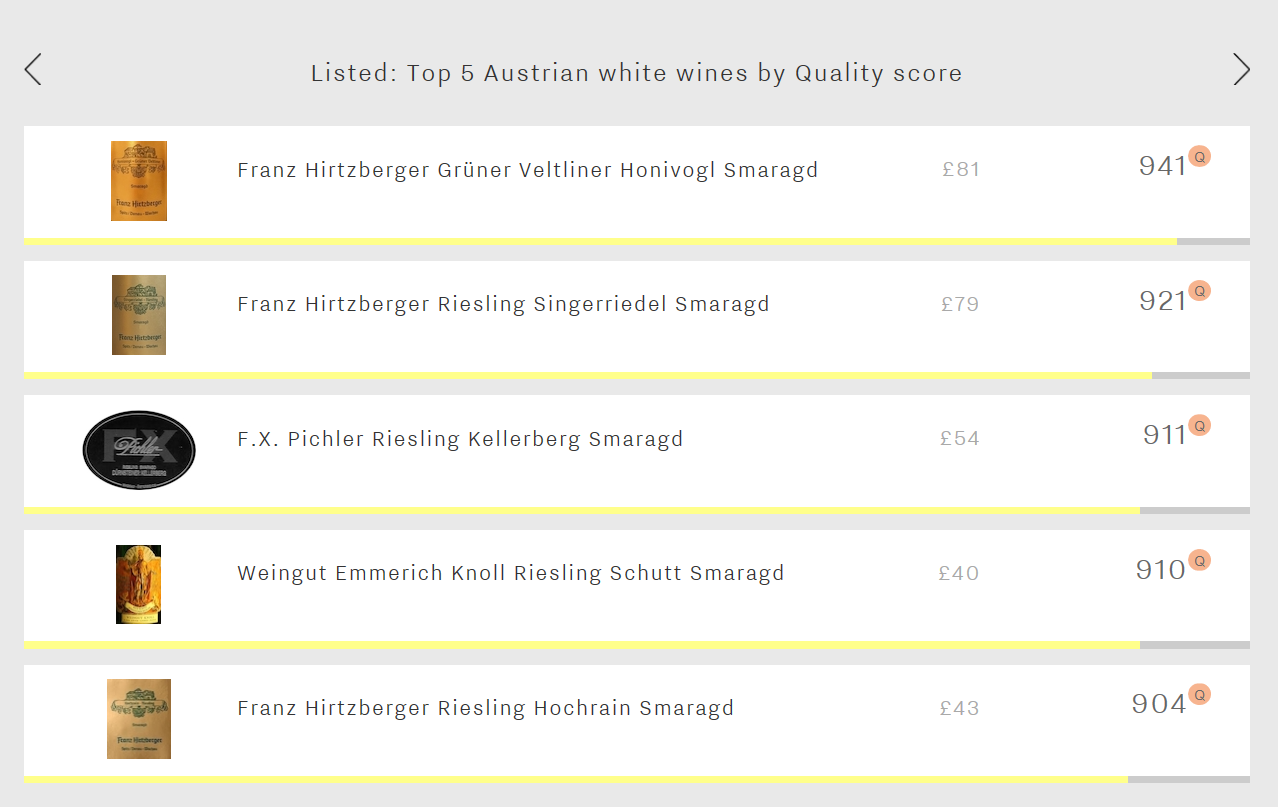
Notably, Franz Hirtzberger produces three of this week’s top five: his Grüner Veltliner Honivogl Smaragd, Riesling Singerriedel Smaragd, and Riesling Hochrain Smaragd demonstrating that he is indeed one of the greatest Austrian producers of dry whites. Leading the way this week is his Grüner Veltliner Honivogl Smaragd with a Quality score of 941. Interestingly, it is the only Grüner Veltliner of the group, with Austria’s national grape otherwise surrounded by Rieslings. At £81 per bottle, it is this week’s most expensive choice. However, it is also Jancis Robinson’s favourite of the five, Wine Lister’s UK partner critic awarding it an excellent average score of 18/20. She was particularly impressed by the 2013, giving it a rating of 18.5/20 and writing: “Spectacularly rich nose. Very ample, intense and flattering. Smoked meat! Kerpow! Not flabby. Great structure. Amazing”.
Franz Hirtzberger’s Riesling Singerriedel Smaragd comes next, and backs up its phenomenal Quality score (921) with this week’s best Brand score (760). Even though its Economics score is considerably lower (503), the Singerriedel is Austria’s overall top-scoring wine, with a Wine Lister score of 781.
F.X. Pichler’s Riesling Kellerberg Smaragd comes in at number three, with a Quality score of 911. This is Vinous’ favourite of the five with an average score of 95/100. Its Quality score is however pulled down slightly by its relatively low average wine life of seven years, making it the shortest-lived wine of the group (which averages nine years). However, it has the most stable price of this group, with volatility of just 2.7%, well below that of this week’s number one, Franz Hirtzberger’s Grüner Veltliner Honivogl, which has volatility of 11.8%.
The two remaining spots are filled by Weingut Emmerich Knoll Riesling Schutt Smaragd in fourth place, and the third wine from Franz Hirtzberger this week, his Riesling Hochrain Smaragd, in fifth place. Although the two come in last in this particular race, both still achieve excellent Quality scores (910 and 904 respectively), partly due to Vinous awarding both an average score of 93.5/100.
Wine Lister’s first in-depth study of Burgundy published earlier this year was named “Mercury Rising” for a reason. With prices climbing more quickly than any other fine wine region, it is hard to consider the possibility of finding Burgundies of “reasonable value”. This week’s Listed blog brings you the top five Côte de Nuits by Quality score that won’t completely rupture the bank (or in other words, for under £200).
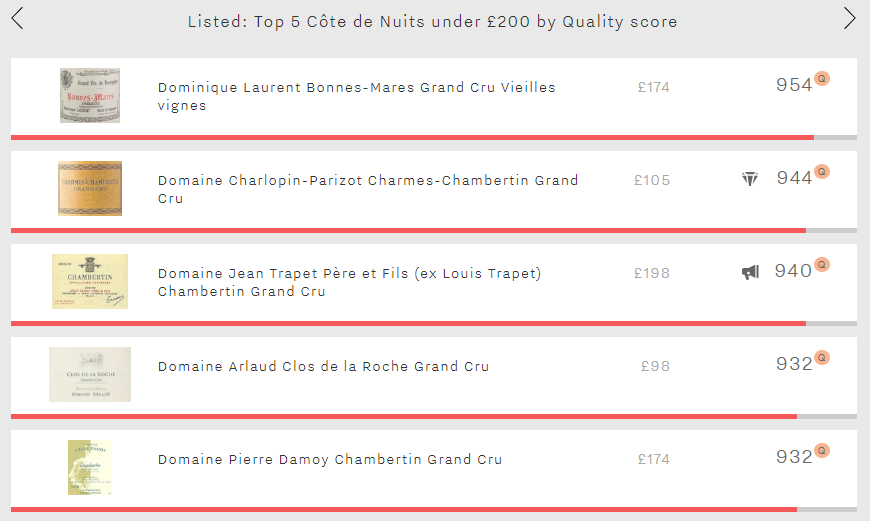
Dominique Laurent takes top spot this week with his Bonnes-Mares Vieilles Vignes, which has a Quality score of 954. Whilst this score sits comfortably amongst the highest of all Bonnes-Mares, the per bottle price of £174 does not – indeed, it is just under five times lower than the combined average price of the other eight best Bonnes-Mares on Wine Lister. Perhaps the lower price can, at least in part, be explained by its modest Brand score (531). For example, despite its Quality score sitting just one point higher, Georges Roumier’s Bonnes-Mares records a Brand score of 934, and is £1,046 more expensive.
In second place is Domaine Charlopin-Parizot’s Charmes Chambertin, with a Quality score of 944. Its high quality is not yet accompanied by an equal level of consumer recognition. With the lowest Brand score of the five (445) resulting from presence in only 2% of the world’s best restaurants and a search frequency ranking of 2,335 (of the c.4000 wines on Wine Lister), this Charmes Chambertin is a Hidden Gem (Wine Lister’s indicator that identifies under the radar wines that warrant discovery).
Domaine Jean Trapet Père et Fils’ Chambertin takes third place this week with a Quality score of 940 and just sneaking in under the £200 mark. While in third place for Quality, it has the highest overall Wine Lister score of the lot (906), thanks to its Brand (868) and Economics (896) scores. Indeed, it beats the combined average scores of the other four wines in this week’s top five in both categories by 310 and 319 points respectively.
The remaining two spots are taken by Domaine Arlaud Clos de la Roche, and Pierre Damoy Chambertin, each with a Quality score of 932. In addition to being by far the cheapest option of this week’s top five (£98 per bottle on average), Arlaud Clos de la Roche’s price is also the most stable, with volatility of just 5.7%. Conversely Damoy Chambertin’s price is the most volatile (8.7%), possibly the result of strong growth rates over both the long and short-term, having recorded a three-year compound annual growth rate of 15.6% and having added 6.5% to its price over the past six months alone.
This week, our Listed blog focuses on Spain’s strongest Brands. Unsurprisingly, and fittingly as we creep into autumn, all are red. It will probably also come as no shock that Bodegas Vega-Sicilia features prominently – filling an impressive three out of five spots on the list, including the top two.
Wine Lister’s Brand score combines a measure of a wine’s prestige – as indicated by its visibility in the world’s top restaurants – with its level of online popularity – calculated by ranking each of the 4000+ wines in our database by monthly search frequency on the world’s most visited wine site, Wine-Searcher. Four of this week’s top five also qualify as Buzz Brands – Wine Lister’s group of wines that perform particularly well when it comes to restaurant presence and online popularity, or are demonstrating a recent growth in popularity, and which are identified by the fine wine trade as trending or especially prestigious.
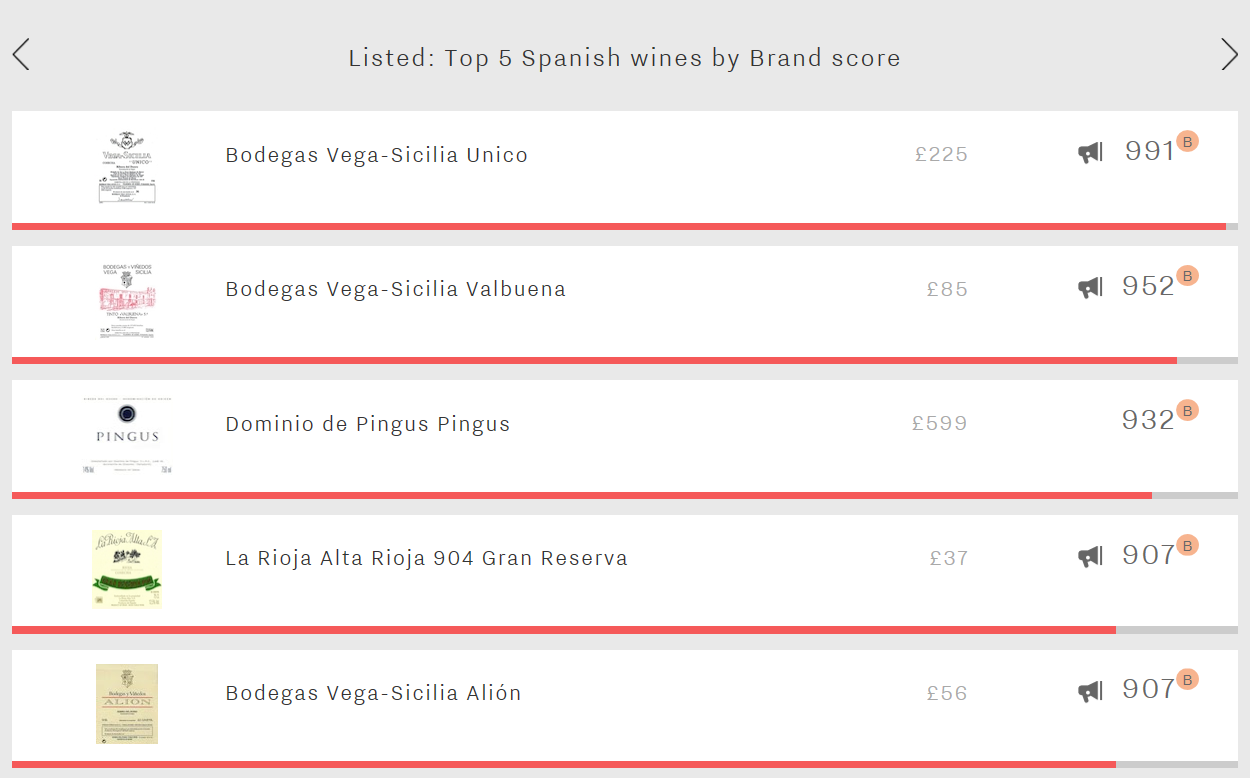
Vega-Sicilia Unico enjoys the best Brand score of any Spanish wine – and is thus the winner of this week’s race. In fact, it also achieves the highest overall Wine Lister score of all Spanish wines (974). Although Unico outperforms the rest of this week’s top five in all three of Wine Lister’s rating categories, its Brand score is particularly impressive (991). This phenomenal score is the result of excellent restaurant presence (47%) and being the 32nd most searched-for of Wine Lister’s wines on Wine Searcher.
Next, with a Brand score of 952 is Vega-Sicilia Valbuena. Despite not being able to match the Bodega’s flagship Unico in any category, it is in terms of brand recognition that it gets closest, its Quality and Economics scores trailing Unico by 115 and 54 points respectively. Its slightly lower – although still impressive – Brand score is the result of being visible in under half the number of restaurants as Unico (23%) and receiving fewer online searches (it is the 119th most popular wine on Wine Lister).
The third wine to make it onto the list is Dominio de Pingus Pingus. Presumably due to its tiny production volumes – only 6,000 bottles of it are produced each year – it is by far the most expensive of this week’s top five, at over twice the price of Unico (£599 vs £225). Its strong Brand – and high price – are supported by excellent Quality, with Pingus achieving the second highest Quality score of the group (935).
The last two places of this week’s top five are occupied by La Rioja Alta 904 Gran Reserva and Vega-Sicilia Alión. Not only do these two have identical Brand scores (907) but, despite contrasting profiles, they also share the same overall score (858). Alión achieves a higher Economics score (874 vs 729), whereas La Rioja Alta 904 records a slightly better Quality score (876 vs 812). La Rioja Alta 904 also shows that strong Brand and Quality scores do not necessarily have to mean soaring prices, as it is by far the most affordable of the five – priced at £37 per bottle on average.
It was with a heavy heart that the global fine wine trade learned of the passing of Barolo legend, Giuseppe Rinaldi, last week. Known for their elegant style and lengthy ageing potential, Rinaldi’s Barolos are not only some of the best that the region has to offer, but also some of the priciest.
In ‘Beppe’ Rinaldi’s honour, Wine Lister looks this week at the top five most expensive wines in Barolo. And there is good reason for these Barolos to be so pricey, with all of the five achieving a Quality score that falls into the “strongest” category on Wine Lister’s 1,000 point scale. On top of this, the first three qualify as Buzz Brands – Wine Lister’s group of wines that combine outstanding restaurant presence with online popularity.
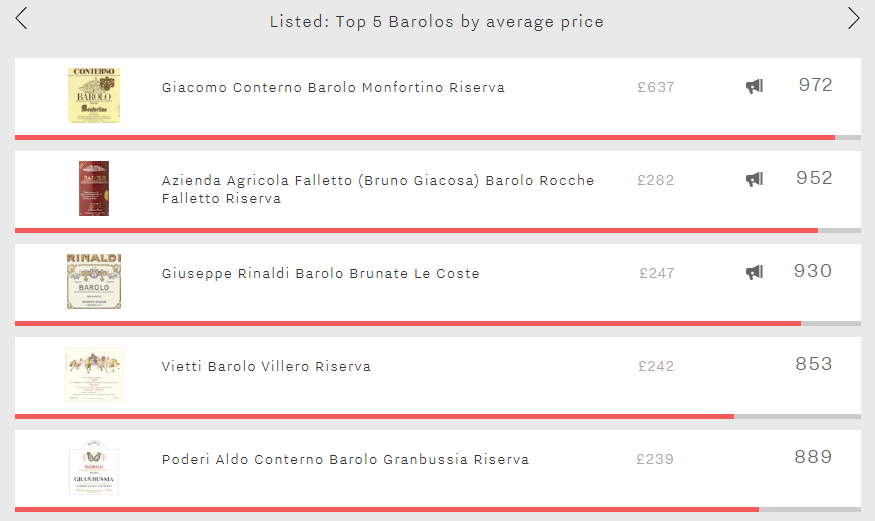
Giacomo Conterno’s Barolo Monfortino Riserva takes first place. At £637 per bottle it is more than twice the price of the rest of this week’s top five. In fact, it is the most expensive Italian wine on Wine Lister. However, it is no coincidence that Conterno’s Monfortino takes first place as it also achieves the group’s best Quality and Brand scores (977 and 969 respectively). Conterno Monfortino is actually the number one Italian wine and 11th best of all wines on Wine Lister, with an impressive overall score of 972.
This week’s second spot is occupied by Azienda Agricola Falletto (Bruno Giacosa) Barolo Rocche Falletto. Even though it competes well with Conterno Monfortino – with Quality and Brand scores of 974 and 914 respectively – it is a considerably cheaper option at £282 per bottle. In fact, despite its lower price, its Economics score is slightly superior to this week’s overall number one wine (969 vs 967), and is the group’s best. Furthermore, it is the second best of all Italian wines on Wine Lister – only beaten by Falletto’s Barbaresco Asili Riserva. The phenomenal Economics score is partly due to a three-year compound annual growth rate (CAGR) of 21.8%.
Giuseppe Rinaldi Barolo Brunate Le Coste takes third place at £247 per bottle. As perfect evidence of Rinaldi’s prowess, it is very consistent across each of Wine Lister’s three rating categories, with each score putting it amongst the very best wines in the world. Confirming its upward trajectory, it records a remarkable three-year CAGR of 36.7% – if it manages to keep that up, it will soon start to narrow the gap to Conterno’s Monfortino in this battle of the Barolos.
The two remaining wines in this group are not only very close in price but they also have the same Quality score (928). This week’s number four – at £242 per bottle – is Vietti Barolo Villero Riserva, followed closely by Poderi Aldo Conterno Barolo Granbussia Riserva at £239. Visible in 17% of the world’s top restaurants, Aldo Conterno’s Granbussia has the second-highest restaurant presence of the group. It is only beaten by this week’s number one, Conterno’s Monfortino, which is visible in 23% of top establishments.
While wines made in The Golden State are not as affected by vintage variation as their European counterparts, the 2013 vintage was for California as close to perfect as they come. The long, hot summer led to Cabernet Sauvignons with extreme fruit concentration and firm structure – a recipe for long-term cellaring. The vintage’s economic credentials seem equally promising, with Economics scores of the top five Californian reds from the 2013 vintage outperforming their respective wine-level average by 114 points (averaging 979 in 2013 versus 864 across all vintages).
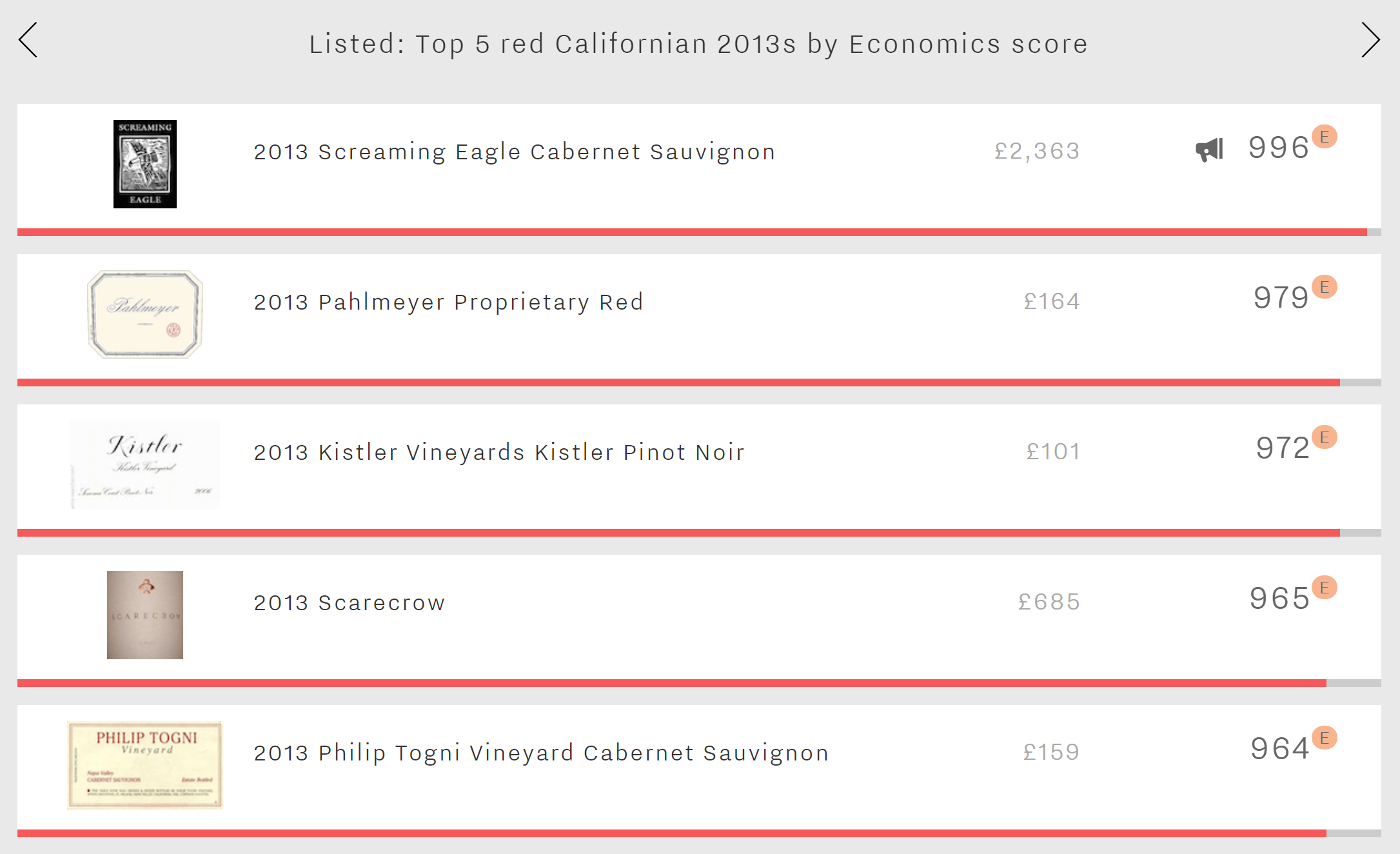
Perhaps unsurprisingly, the number one spot is taken by Screaming Eagle Cabernet Sauvignon. At 996, its Economics score is not only the highest of this week’s top five, but of all 2013s on Wine Lister (matched only by 2013 DRC Richebourg). It is also by far the most expensive of the five at £2,363 per bottle – over twice as high as the price of the other four combined. Screaming Eagle’s “mailing list” sales model teamed with tiny production quantities (7,800 bottles per annum on average) means that demand for this wine consistently outweighs supply. This could explain the wine’s strong presence on the secondary market, with 855 bottles traded at auction over the last 12 months (according to figures collated by the Wine Market Journal).
In second place is 2013 Pahlmeyer Proprietary Red. Interestingly, it has the lowest Quality score of the group. Indeed, its 2013 Quality score is 74 points lower than Pahlmeyer’s average (848). Contrastingly, the 2013 vintage receives its best ever Economics score of 979, boosted by a six-month price performance of 18.7%.
The third spot of this week’s top five is occupied by the only Pinot Noir of the group, Kistler Vineyards Pinot Noir, with an Economics score of 972. It is the only wine of the five to have been released before 2016, and thus the only one with a three-year compound annual growth rate (28.2%), whereas Economics scores for the other four 2013s are based upon price performance over the short term only. Kistler’s place in the top five 2013 Californian reds by Economics score is impressive, given its lower price point (£101 per bottle, compared with an £843 average for the other four wines).
The penultimate wine of this week’s top five is 2013 Scarecrow. Alongside its best ever Quality score (987), the 2013 vintage achieves an Economics score of 965, helped by the second-highest three-month average price (£663) and the best price stability of the group (with standard deviation of just 4.1% over the last 12 months).
Last but by no means least is Philip Togni Vineyard Cabernet Sauvignon, with an Economics score of 964. Though fifth for economics, it is number one for Quality, thanks to a 100-point score from Wine Lister partner critic, Antonio Galloni, who calls it “a majestic, towering wine… one of the wines of the vintage”.
Buzz Brands are wines that are sure to turn heads, destined to cause a stir whenever they are opened. They combine excellence across Wine Lister’s two Brand criteria – restaurant presence and online popularity – whilst also being held in the highest regard by the fine wine trade – as confirmed by Wine Lister’s Founding Members’ survey which gathers the opinions of around 50 key players in the international wine trade. This week, the Listed section focuses on Italy’s top five Buzz Brands by overall Wine Lister score.
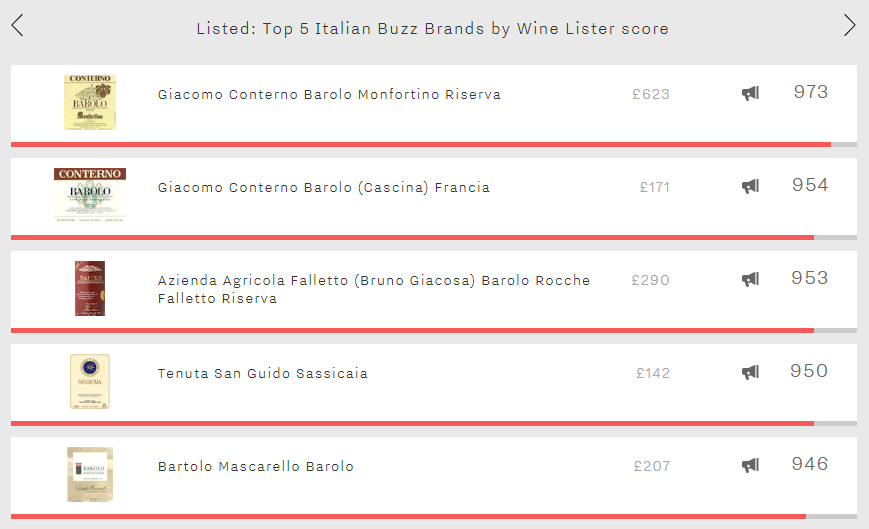
Barolo is home to four of Italy’s top five Buzz Brands, two of which are produced by Giacomo Conterno – the flagship Monfortino in first place (973) and Francia not far behind in second place (954). The Monfortino achieves Italy’s best Quality score (977), the result of remarkable consistency from vintage to vintage, having achieved a score of 993 or above in seven of the past 10 vintages. Its best ever vintage was 2004 (998), thanks to a perfect 100-point score from Antonio Galloni, who writes: “I imagine the 2004 Monfortino will give readers an utterly spellbinding drinking experience for the next few decades”.
Whilst the Francia is pipped at the post in each category by its illustrious stablemate (trailing by 17 points in the Quality category, 11 in the Brand category, and 34 in terms of Economics), it does manage superior restaurant presence, visible in 30% of the world’s top establishments, compared to the Monfortino’s 23%. This is presumably due to over three times as many bottles of it being produced each year on average.
In third place is Azienda Agricola Falletto’s Rocche Falletto Riserva (953). It records the best Economics score of the five (969) and Italy’s second-best, beaten only by Falletto’s Barbaresco Asili Riserva (978). It does so thanks to the combination of very strong growth rates – it has recorded a three-year compound annual growth rate of 21% and has added 8% to its value over the past six months alone – and strong liquidity – its top five vintages having traded 398 bottles at auction over the past year. Perhaps collectors have been eager to get their hands on a bottle after the passing of Bruno Giacosa in January.
Proving that Super Tuscans can mix it with Piedmont’s top nebbiolos, Sassicaia takes fourth place. Whilst it cannot keep pace with Barolo’s finest in the Quality and Economics categories, Sassicaia stretches out a comfortable lead in the Brand category thanks to an extraordinary score of 998. This near-perfect score puts it alongside Haut-Brion, Margaux, and Petrus, beaten only by the Pauillac First Growths, Dom Pérignon Vintage Brut, and Yquem. Its brand dominance is the result of outstanding restaurant presence (49%) and online popularity – receiving well over three times as many searches each month as Conterno’s Monfortino, which is the group’s second-most popular wine.
Rounding out the five is Bartolo Mascarello’s Barolo. Its brand is its strongest asset, its score of 964 making it Barolo’s second-strongest brand behind Conterno’s Monfortino. Despite receiving over 20% fewer online searches each month than the Monfortino, it matches its level of restaurant presence – perhaps the azienda’s famous “no barrique no Berlusconi” message strikes a chord with sommeliers.
This week’s Listed blog will for most be an exercise in window shopping (or perhaps lèche-vitrine might be more appropriate). Not just the eye-watering prices, but also the extreme rarity of this week’s top five – just 500 bottles of d’Auvenay’s Chevalier-Montrachet are produced each year – act as bouncers stopping all but the most fortunate from entering this exclusive Burgundian showroom. Nevertheless, we can at least vicariously get as close to Chardonnay nirvana as possible with the Côte de Beaune’s five most expensive wines.
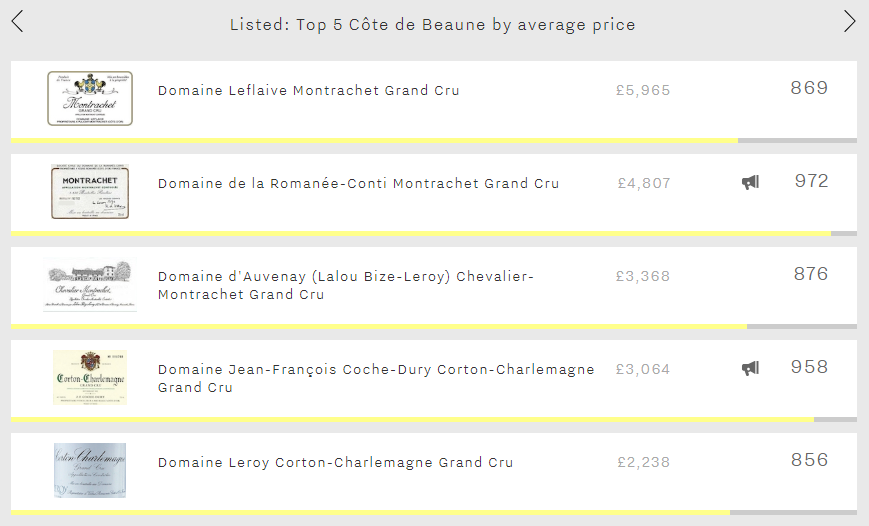
And these five really do get close to Chardonnay perfection, with a remarkable average Quality score of 975, putting them all amongst the top 15 still dry whites for Quality on Wine Lister. Perhaps reassuringly, Leflaive’s Montrachet, the Côte de Beaune’s most expensive wine, achieves the group’s best Quality score (985). 2010 was its best ever vintage, with a Quality score of 990, Jancis Robinson awarding it 19.5/20 and calling it: “[…] Not rich but gorgeous. Pale gold and obviously much fuller and deeper than Leflaive’s other grands crus. Rich yet so fresh! Nutty. Amazing concentrated fruit has already triumphed over the new oak. Very racy […]”. Interestingly, at £4,400 per bottle the 2010 is currently priced below all recent vintages other than the 2003.
Descending from the dizziest of heights, in second place is DRC’s Montrachet (£4,807). It is not just the Côte de Beaune’s overall top-scoring wine, but the best still dry white on Wine Lister (972). It is remarkably consistent across each of Wine Lister’s three rating categories, with Quality, Brand, and Economics scores of 975, 960, and 987 respectively. It is its Brand score that helps it nudge ahead in this Côte de Beaune showdown, with Coche-Dury’s Corton-Charlemagne the only one of the group to get close (924), the other three lagging c.250-290 points behind. Its brand superiority is the result of dominating both in terms of restaurant presence (visible in 26% of the world’s best establishments, comfortably above the Coche-Dury’s 19%) and online popularity (receiving 65% more searches each month than the Coche-Dury).
Whilst the Coche-Dury can’t quite match DRC’S Montrachet in the Brand or Quality categories, it does achieve the same phenomenal Economics score (987), having registered a superior three-year compound annual growth rate (25% vs 22%) and being the most-traded of the group at auction.
Lalou Bize-Leroy features twice in the list, first with d’Auvenay’s Chevalier-Montrachet (£3,368) and secondly with Domaine Leroy’s Corton-Charlemagne (£2,238). If ever there was proof of the life-altering potential of these hallowed wines, of his first taste of d’Auvenay’s Chevalier-Montrachet 1996, Wine Lister’s newest partner critic Neal Martin writes: “I took a large sip. It was like a thunderbolt hitting my senses: the tension, the complexity and intensity sent shivers down my spine. It was difficult to put down in words, yet this wine became instantly and indelibly etched onto my brain. Now I understood why oenophiles genuflected at the altar of white Burgundy”. With the d’Auvenay achieving a three-year compound annual growth rate of 45% and having added 18% to its value over the past six months alone, experiences such as Martin’s are only getting further out of reach for most.
The d’Auvenay is not alone in its soaring prices. As the chart below shows, demand for all of this week’s top five has skyrocketed over the past three years, each having added at least 62% to its value since July 2015. It seems the majority of us will have to satisfy ourselves with window-shopping for a little while longer.
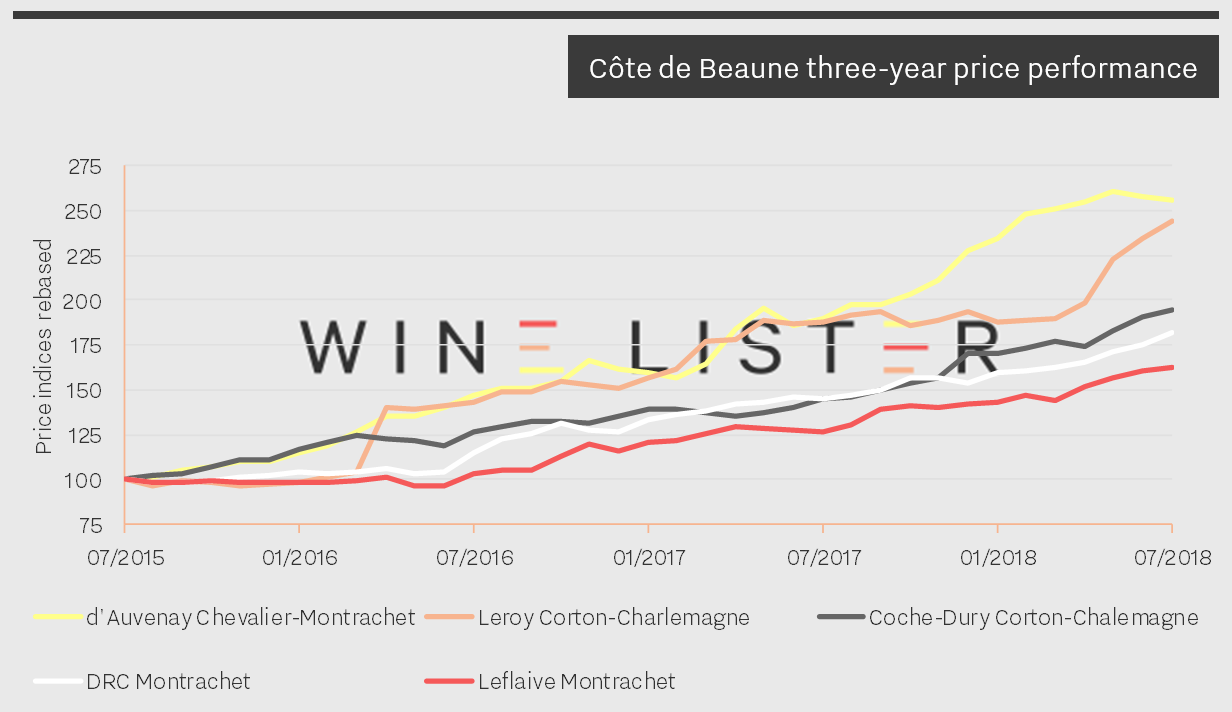
Price nearly always plays a part in the decision-making process of purchasing wine. Typically, much emphasis is placed on the importance of “value” – “how much quality am I getting for the price of this bottle”, for which Wine Lister has its very own indicator, Value Picks. However is simply offering “good value” enough?
Wines purchased for long-term cellaring carry financial risk just as investment does. With this in mind, Wine Lister’s Economics scores reflect not only a wine’s price, but the performance of that figure over time. As well as a three-month average market price, and six-month / three-year price growth, Wine Lister’s algorithm takes into account price stability as a factor in determining a wine’s Economic strength.
Using historical prices provided by our data partner, Wine Owners, we calculate the standard deviation of a price over the last 12 months, expressed as a proportion of the average price over the same period.
Volatility can be caused by price movements both up and down. Nobody wants to see the price of a wine plummet after purchase, but equally, wines with prices rising too high and too fast display risk too, and are therefore also sanctioned with lower Economics scores.
Below is an extract from this year’s Bordeaux Market Study featuring the 15 most stable Bordeaux wines. All five left bank first growths appear, testament that higher-scoring wines tend to experience less volatility. This is also tied in with liquidity: frequently traded wines tend to benefit from multiple reference points allowing a consistent market price to be determined. Conversely, a wine traded less frequently often sells at a markedly different price from one transaction to the next, resulting in a much more volatile market price.

While Château Latour’s slow and steady price growth (as shown in the chart below) results in relatively low six-month price performance and three-year compound annual growth rate (CAGR) ratings, its strong Economics score is thanks to a high three-month average price, a high volume of bottles traded at auction, and a low price deviation of just 2.4% over the last 12 months.


The chart below shows a very different picture – this wine has experienced a 14.7% price increase in six months. Though this in itself is positive, its price has therefore deviated 12.5% in the last 12 months, and the yo-yoing nature of the price over the longer term earns it a much lower Economics score (492).
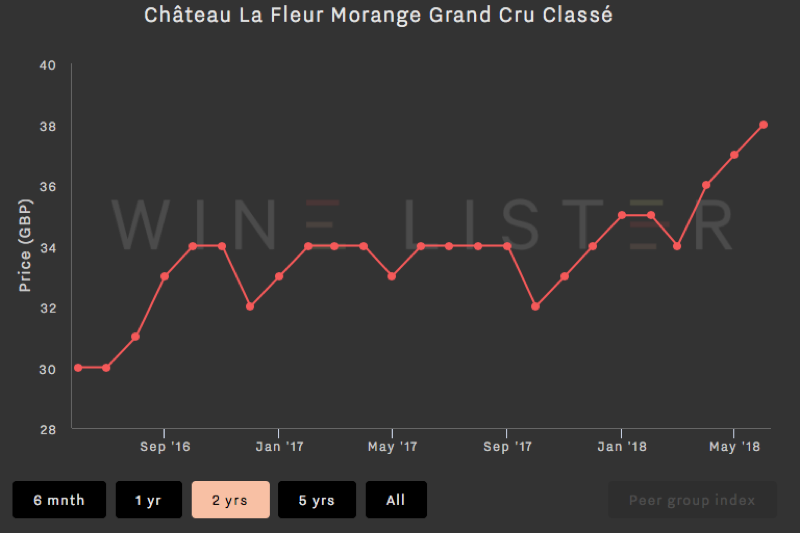
With England progressing serenely (ahem) through their round of 16 match against Columbia, much Champagne (and probably much more beer) will have been drunk on Tuesday evening. With somewhat tortuous logic therefore, this week’s Listed section focuses on the best Champagnes from the 2000 vintage by Economics score.
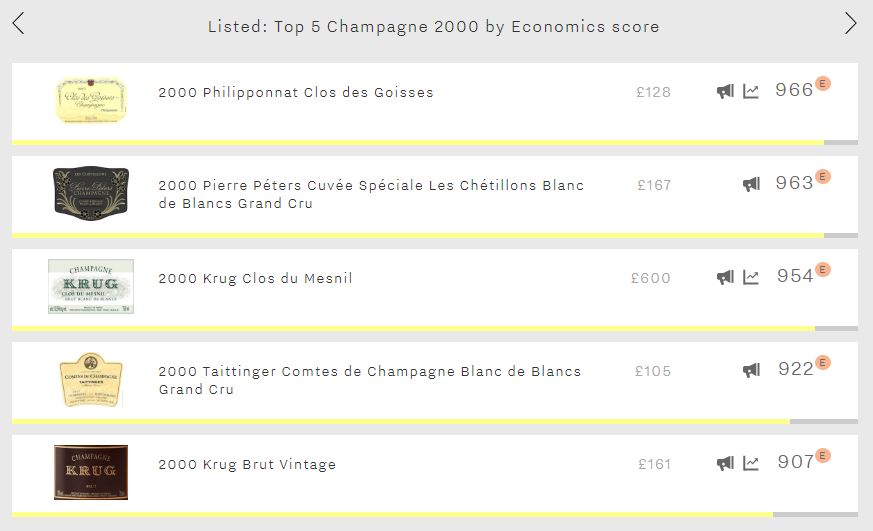
Separated by just three points at the top of the table are Philipponnat Clos des Goisses (966) and Pierre Péters Cuvée Spéciale Les Chétillons Blanc de Blancs Grand Cru (963). Despite experiencing the lowest Quality score of the five – a nonetheless hugely respectable 944 – the Philipponnat gets its nose ahead thanks to excellent growth rates over both the long and short-term, with a three-year compound annual growth rate (CAGR) of 20% and having added 33% to its price over the past six months alone. No wonder it is one of the group’s three Investment Staples.
It is interesting that Pierre Péters Cuvée Spéciale Les Chétillons Blanc de Blancs Grand Cru comes in second place in terms of Economic performance, despite it experiencing the group’s lowest overall Wine Lister score for the vintage (910). Its lower Wine Lister score is the result of its Brand score (822) being the weakest of the group by nearly 90 points, confirming the phenomenal head start that the globally renowned houses have over grower Champagnes in terms of brand recognition. It manages second place in terms of economic performance thanks to formidable short-term growth rates, its price having risen 42% since January.
In third place is Krug’s Clos du Mesnil (954), one of three Blanc de Blancs in this week’s top five, and the first of two wines from Krug, with the Brut Vintage recording an Economics score of 907. The two Krugs are almost inseparable, the Brut Vintage’s Wine Lister score of 967 just one point ahead of the Clos du Mesnil, making them the overall top-scoring Champagnes of the vintage. Our partner critics were barely able to separate them either, the Clos du Mesnil’s Quality score just two points ahead (976 vs 974). However, the rarity of the Clos du Mesnil results in it being over 3.5 times more expensive. Furthermore, with the Clos du Mesnil recording a 3-year CAGR of 14% and short-term growth rates of 12%, the price discrepancy is increasing – the Brut Vintage has a 3-year CAGR of 8% and has increased in value by 4% over the past six months. However the feather in the cap for the Brut Vintage is that it is considerably more liquid – presumably because of larger production volumes – its top five vintages having traded 1,279 bottles at auction over the past four quarters, over 11 times as many as the Clos du Mesnil (112).
The remaining spot is filled by Taittinger Comtes de Champagne Blanc de Blancs Grand Cru (922). It is the second-most liquid of the group, its top five vintages having traded 720 bottles at auction over the past year.
Incidentally, 2000 was a European Championships year, not a World Cup year. Fittingly, given the focus of this blog, France won. England failed to make it past the group stages.
As a sort of postscript to the difficult 2017 en primeur campaign (read our CEO Ella’s thoughts here), over the past week or so Pomerol powerhouses Petrus and Le Pin were released at £1,480 and £1,750 per bottle respectively. With Pomerol wines achieving the top three Quality scores of all reds for 2017 – and five of the top 10 – it was the top-performing red appellation of the vintage.
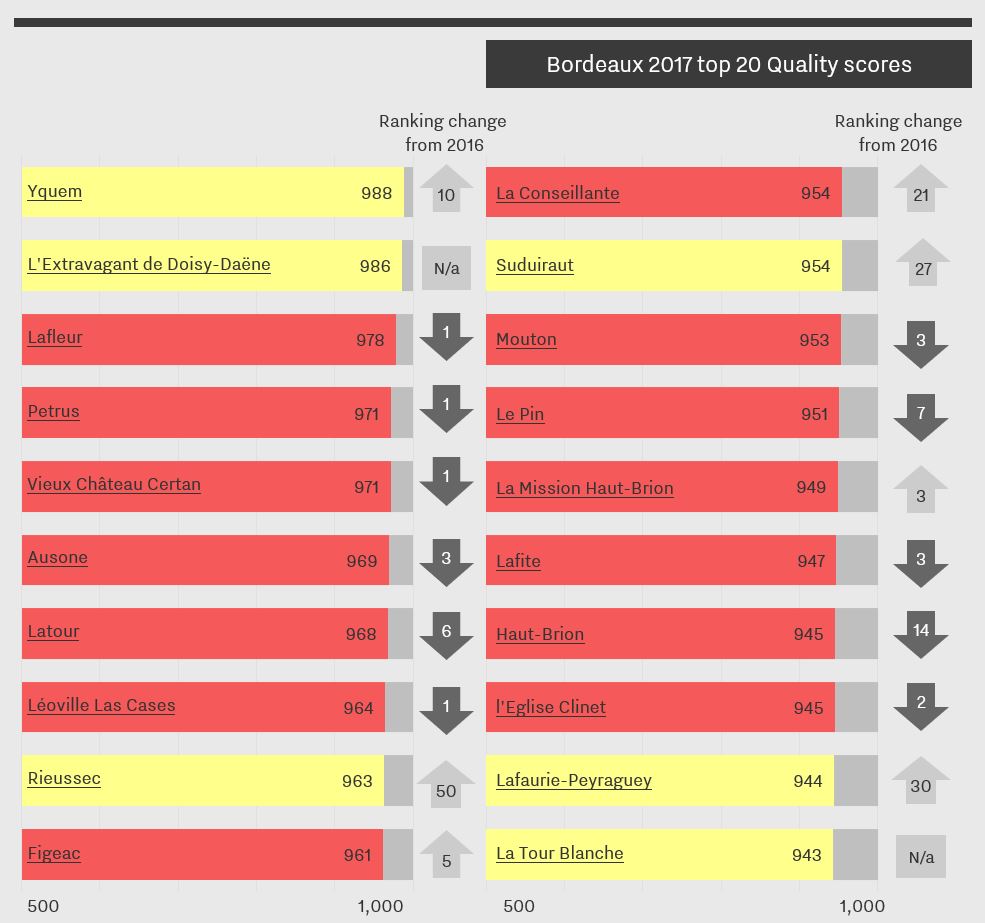
Now that we have release prices for all of Pomerol’s top wines, we can see which came out on top in terms of overall Wine Lister score*.
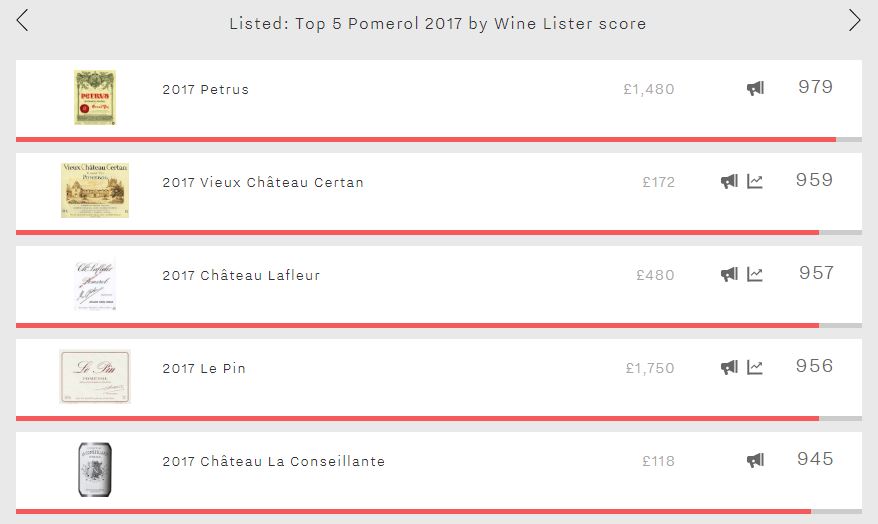
With a score of 979, Petrus was not just Pomerol’s leading wine of 2017, but the number one wine in Bordeaux. This is perhaps unsurprising given that it received the joint-second best Quality score of the vintage of all reds (971) – alongside Vieux Château Certan – and also has a Brand score of 998 (beaten only by Lafite, Latour, Mouton, Yquem, and Dom Pérignon Vintage Brut) along with a wine-level Economics score of 978 (third-best in Bordeaux). With Wine Lister’s Founding Members voting it the second-most prestigious wine in the world in a recent survey, behind DRC La Romanée-Conti, Petrus is currently unbeatable in Bordeaux.
Number two on the 2017 Pomerol leaderboard is Vieux Château Certan (959). While the confidence rating attributed by Wine Lister’s Founding Members slipped a point over the past year from 9/10 to 8/10, it nevertheless achieves Pomerol’s second-best Brand score (972). Thus, despite its relatively modest Economics score (909) – still putting it amongst the very best on Wine Lister’s 1,000 point scale – the 2017, thanks to its excellent Quality score, manages to edge just ahead of Lafleur in terms of overall Wine Lister score (957).
Lafleur 2017, the best red wine of the vintage for Quality (978), was released in early May at £430 per bottle, a 7% decrease on the 2016 release price. This was Neal Martin’s favourite of the five, Wine Lister’s newest partner critic awarding it a score of 95-97 /100 and commenting: “This is an awesome 2017 from Baptiste Guinaudeau, one of the few that will oblige several years in the cellar”.
Le Pin 2017 was released in the UK at £1,750 per bottle, its 25% decrease on the 2016 release price the largest year-on-year reduction of the five. It experiences the lowest Quality score of the five for the vintage (951), and also has the group’s lowest Brand score (944). The fact that the 2017 betters Lafleur and La Conseillante in terms of overall Wine Lister score is thus the result of its formidable Economics score (980), which it achieves not just because of its high average price but also strong growth rates, which are the best of the group over both the long and short-term.
Rounding out the group is La Conseillante (945). Whilst it is by far the most affordable of the group, it is the only one of the five whose 2017 climbed the Bordeaux Quality score table compared to 2016, surging 21 spots to be the eighth best red and 11th best overall.
Remember that you can catch up on all of the campaign’s releases on our dedicated en primeur page.
* Please note that overall Wine Lister scores for en primeur wines use estimated Economics scores based on the performance of back vintages.














